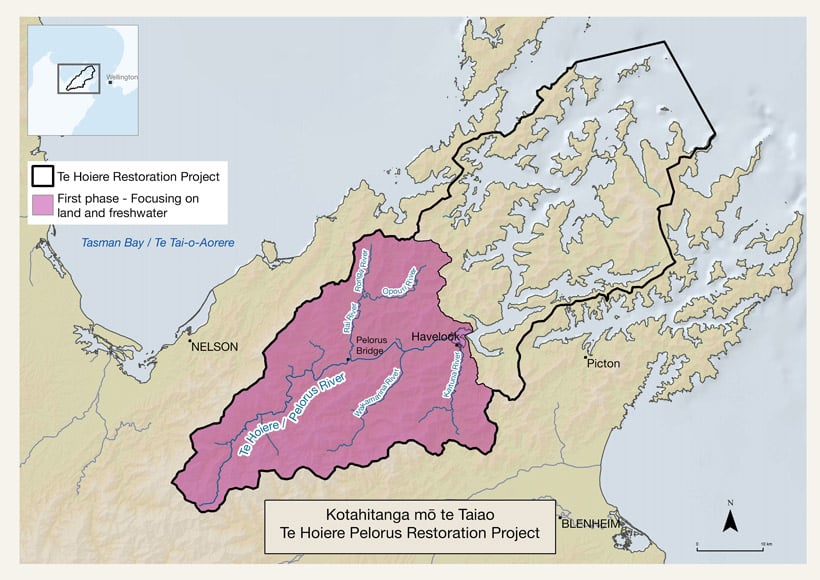Work to look after nature and restore freshwater quality in Te Hoiere/Pelorus River catchment is getting a significant boost, thanks to new government funding support Minister for Conservation Eugenie Sage announced in Canvastown today.
"Every New Zealander should be able to swim in their local river without getting sick, and rivers should be healthy for fish and other wildlife and for gathering mahinga kai. Currently Te Hoiere/Pelorus River is at risk and needs a helping hand to improve water quality for its own sake, and for people now and into the future" said Eugenie Sage.

Map of the Te Hoiere Restoration Project area
More funding for the Te Hoiere/Pelorus River catchment is part of the government's action plan to clean up New Zealand's waterways in a generation to make them safe for swimming.
Te Hoiere/Pelorus is the second at-risk catchments identified for restoration, after Northland's Kaipara catchment with more to be announced over the coming months.
"Restoration of river health requires a united effort led by the community, involving landholders, iwi, councils and community organisations helped by government funding support."
Te Hoiere/Pelorus is one of 14 priority catchments around the country identified for a share of $8 million of funding through the Department of Conservation's Te Awa programme to restore the catchments to a healthy, functioning state. In addition the catchment will receive a share of the Ministry for the Environment's $12 million funding as part of an 'at risk' catchment programme.
"Te Hoiere/Pelorus catchment is set for a new phase of community-led landscape-scale restoration that could provide a leading example for restoration projects around the country," said Eugenie Sage.
"Te Hoiere/Pelorus is home to at least 14 native freshwater fish species, nine of which are either threatened or at risk of extinction. It's also home to kākahi (freshwater mussels), koura (freshwater crayfish) and freshwater shrimp.
The catchment supports recreation, agriculture, forestry and marine farming.
"Pekapeka/long-tailed bat, tarāpuka/black-billed gull, speckled skink, shortjaw kōkopu, carnivorous snails and very rare plants like the pygmy button daisy live in Te Hoiere/Pelorus – and that's just to name a few. A successful restoration could see whio/blue duck return one day which would be amazing."
The project is part of the Kotahitanga mō te Taiao Alliance – a collaborative way of iwi, local and central government working with the community across the Top of the South Island to achieve mountains to sea restoration that will benefit nature, and people connected to nature.
"The farming community have made significant improvements to land and water management with support from the NZ Landcare Trust and Marlborough District Council. Forest and Bird is leading a nationally important Bat Recovery Project supported by Ngāti Kuia and DOC. Te Hoiere/Pelorus project builds on and helps strengthen this co-operation.
"Te Hoiere/Pelorus catchment faces some significant freshwater challenges, particularly from increased sedimentation, so I'm pleased to see the leadership shown by the Kotahitanga mō te Taiao Alliance to make their waterways healthier.
"Cleaning up our rivers and lakes over a generation is a priority environmental issue for New Zealanders. I am eager to see what can be achieved and what we can learn from this additional support from government,"
Background information
Te Hoiere/Pelorus River is the largest river catchment draining into the Marlborough Sounds. Native forest cover dominates the upper parts of the catchment, particularly the Upper Te Hoiere and the Wakamarina.
- Te Hoiere/Pelorus River catchment is classified as 'at risk'. Although Te Hoiere/Pelorus River has good quality in its lower reaches, its sub-catchments including the Rai and Kaituna are impacted by E.coli and concentrations of nitrogen. These sub-catchments are classed as 'fair'.
- DOC is investing $8 million of Budget 2018 Government funds in its Te Awa programme to support the ecological restoration of 14 priority river catchments until 2022, ramping up to $4 million per year thereafter.
- Priority river funding will put more staff on the ground and provide more technical expertise so DOC can work with partners and communities on the best ways to restore river catchments.
- The Government has also invested $229 million to improve land use and our waterways in Budget 2019, including for freshwater. Exemplar catchments is an on-ground programme funded from $12 million of Government funding over four years. Government support will boost community work already underway by taking a whole of government approach to support community action to improve water quality.
- Te Hoiere/Pelorus River is the second exemplar catchment announced to date. The first was Kaipara, announced by the Government in August.
- The Government wants to make a real difference in catchments that have serious issues and develop a research base to guide national environmental improvements. These first exemplar catchments provide the opportunity to learn and develop partnerships, while continuing to build national-level information.






